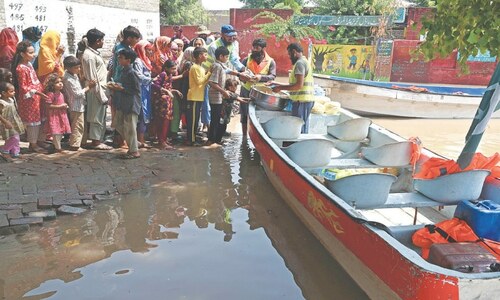From Abid Usman
Lahore: More than 74,000 people have been evacuated from flood-affected areas between July 9 and August 22 as the Sutlej river continued to see high-level floods at Sulemanki Headworks on Wednesday.
Farooq Ahmad, spokesman for the Punjab emergency services, confirmed the figure, adding that a total of 16 people have lost their lives while 36 have been injured from July 9 to August 22 due to the floods. A total of 408 boats and 1,489 rescuers have been engaged in rescue efforts during the said period.
Meanwhile, media quoted Punjab Provincial Disaster Management Authority (PDMA) Director General (DG) Imran Qureshi as stating that nearly 3,000 people and livestock each have been moved to safer places.
The official further said that rescue and relief activities continued round the clock in flood-hit areas of the province as over 700 rescue personnel were performing their duties while 58 medical camps were functional.
In a statement issued earlier today, the PDMA stated that there was a high-level flood at the Sulemanki Headworks, with the flow of water at 155,330 cusecs.
It added that the flood level at Ganda Singh Wala Barrage receded from a high-level flood to medium, with the flow of water at 118,652 cusecs.
Stating that there was a low-level flood at the Islam Headworks, the PDMA cautioned that the water level there was rising rapidly, with the flow of water at 73,559 cusecs. The map below, shared by the PMD’s Lahore Flood Forecasting Division, shows the flow of water at 12pm today at the three different points.
The authority forecasted a high-level flood at Islam Headworks during the next 24 hours and alerted the local administration as well.
While it stated that the flood levels at other rivers in Punjab were “normal”, the PDMA warned that there was a risk of a high-level flood at Mangla in Jhelum River in the next three days.
A forecast by the Pakistan Meteorological Department (PMD) stated the same, warning of “sharp peaks of medium to high-level floods” from August 24-25 at Mangla.
It further warned, “Flows in Sutlej river may rise again subject to [water] releases from India.”
The forecast added that “scattered to widespread wind-thunderstorm/rain of moderate intensity with isolated heavy falls” was expected over the upper catchments of all major rivers.
A flood warning alert issued earlier today by the Punjab PDMA directed the local authorities to ensure sufficient staffing round the clock. It also ordered the removal of settlements along Sutlej River and to ensure that breaching sites were operational.
The PDMA further directed Rescue 1122 to remain on “high alert” and have sufficient emergency response personnel and equipment during the forecasted period.
In another statement, the PDMA DG said that 769 officials have been deployed in various flood-affected districts during the past 24 hours, including Bahawalnagar, Kasur, Okara, Pakpattan, Vihari, Multan and Lodhran.
Qureshi added that a total of 113 villages have been affected by floods during the past 24 hours, with medical facilities provided to more than 2,000 people and 44 relief camps set up.
Emergency transport was provided to around 1,200 people while 2,616 people stuck in floods were rescued on an emergency basis, he said.
The PDMA DG added that cooked food was distributed to around 1,500 while more than 85,000 acres of land have been affected by the floods.
Qureshi also visited areas in Okara that have been impacted by flooding, where he assessed the ongoing relief operations and engaged with the administrative officials there.
Separately, Punjab Relief Commissioner Nabeel Javed directed the local authorities to stay alert and said that aid efforts would continue till the evacuation and rehabilitation of the residents had been concluded.
Punjab interim Chief Minister Mohsin Naqvi has said that monsoon rains had prompted authorities in India to release excess reservoir water into the Sutlej river, causing flooding downstream on the Pakistani side of the border.
Meanwhile, the PMD has warned that another monsoon spell is likely to lash the upper parts of the country from today till August 27.
According to the Met Department, monsoon currents from the Arabian Sea were likely to penetrate the upper parts of the country from last night whereas a westerly wave is also likely to enter in these areas today.
Under the influence of these systems, rain and wind-thunderstorms are expected in different parts of Kashmir, including Neelum, Muzaffarabad, Poonch, Hattian, Bagh, Haveli, Sudhanoti, Kotli, Bhimber and Mirpur.
The warning has also been issued for different parts of Gilgit-Baltistan, Murree, Galliyat, Islamabad, Rawalpindi, Attock, Chakwal, Jhelum, Mandi Bahauddin, Hafizabad, Gujranwala, Gujrat, Sialkot, Narowal, Lahore, Kasur, Sheikhupura, Chitral, Dir, Swat, Shangla, Buner, Mansehra, Kohistan, Abbottabad, Haripur, Kohat, Peshawar, Mardan, Swabi and Nowshera from August 23 to 27 with occasional gaps.
The warning stated that moderate to heavy falls are expected to increase the water flows in local nullahs/streams of Kashmir, Gilgit Baltistan, Chitral, Dir, Swat, Kohistan, Shangla, Buner, Mansehra, Abbottabad, Mardan, Nowshera, Swabi, Galliyat, Murree, Rawalpindi/Islamabad from August 23 to 25.
Moreover, moderate to heavy rains may cause urban flooding in the low-lying areas of the twin cities of Rawalpindi and Islamabad, Peshawar, and Lahore as well as may trigger landslides in the vulnerable areas of Murree, Galliyat, Kashmir, Gilgit Baltistan and hilly areas of Khyber Pakhtunkhwa during the wet spell.
The dam operators have been asked to manage reservoir levels accordingly. Prevailing hot and very humid conditions are likely to subside during the spell. Farmers have been advised to manage their activities keeping in view the weather forecast.
Similarly, tourists and travellers were recommended to remain extra cautious to avoid any untoward situation during the spell. Wind-thunderstorms may damage loose structures like electric poles, solar panels, etc which is why the public has been cautioned to stay at safe places during wind-storms/lightning/heavy rains.



